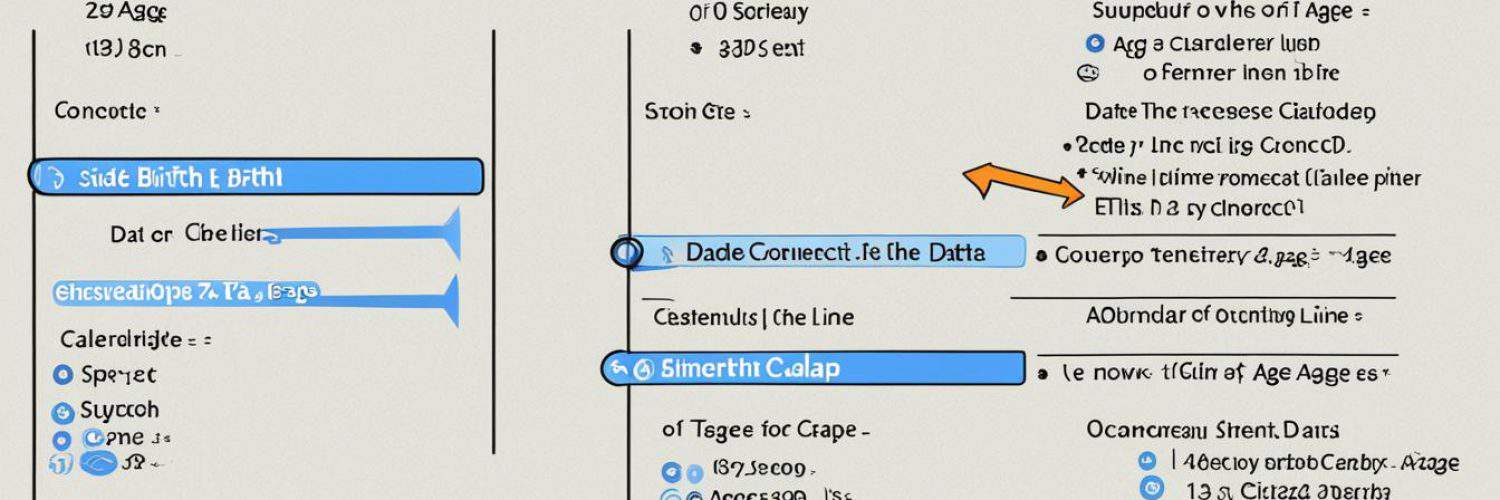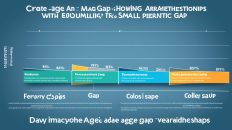Are you curious about the age difference between you and your partner? Or maybe you want to determine the age gap between any two individuals? Look no further than our accurate age gap calculator! This easy-to-use tool allows you to compute the age difference with just a few clicks. Whether you’re calculating the age gap in a relationship or simply comparing ages, our calculator delivers precise results in seconds.
Key Takeaways:
- Our age gap calculator quickly and accurately measures the age difference between two individuals.
- It provides the exact age difference in years, months, and days.
- The calculator can be used with birth dates or ages, giving you flexibility in how you input the data.
- Remember, age is just one aspect of a relationship, and factors such as shared values and communication skills are equally important.
- Use the age gap calculator as a starting point for discussions and self-reflection, rather than as the sole determinant of compatibility.
How to Use the Age Difference Calculator
The age difference calculator is a versatile tool that makes it easy to calculate the age gap between two people. You can use this calculator by entering the ages, years of birth, or dates of birth of both individuals. The order of entry does not matter, as the calculator will compute the age difference based on the information provided.
If you choose to enter ages, the calculator will determine the age gap in terms of years. Simply input the ages of the two individuals, and the calculator will provide the age difference.
If you prefer to enter years of birth, the calculator will calculate the age difference based on the difference between the two years. This option is useful if you don’t know the exact ages but have the years of birth available.
If you have the dates of birth, this option will yield the most precise results. The calculator will calculate the age difference in years, months, weeks, and days, providing a comprehensive breakdown of the age gap.
Here is an example of how the age difference calculator works:
Person A: 25 years old
Person B: 30 years old
The age difference calculator will compute that the age gap between Person A and Person B is 5 years.
Alternatively, if the dates of birth are provided:
Person A’s Date of Birth: April 10, 1990
Person B’s Date of Birth: August 15, 1985
The calculator will determine that the age difference between Person A and Person B is 4 years, 4 months, 5 weeks, and 2 days.
Using the age difference calculator is simple and straightforward. It accommodates various inputs and provides accurate results regardless of the information available. Whether you know the exact ages or have only the years of birth or dates of birth, this tool will help you calculate the age gap quickly and easily.
Age Difference Formula
Calculating the age difference between two individuals is made simple with the universal Age difference formula. By using the absolute function (ABS()), we can ensure accurate results and avoid negative values. The formula itself is straightforward: |Age 1 – Age 2|. This formula can be applied using either ages or years, allowing for flexibility in the inputs provided. Additionally, if the dates of birth are available, the age difference can even be calculated down to the exact day. It’s important to note that leap years may require adjustments in the date difference calculation, accounting for the additional day in February.
“The age difference formula is a powerful tool, providing a quick and precise way to determine the age gap between two individuals. Its versatility allows for calculations based on ages, years, and even dates of birth, providing invaluable insights into the relationship dynamics.”
The Age Gap in Dating and Relationships
An age difference calculator can be a valuable tool when it comes to assessing the age gap between potential romantic partners. While there are no definitive rules in dating and relationships, understanding the dynamics of age differences can help individuals navigate their romantic lives with more clarity and confidence.
In society, there is a general guideline known as the “rule of seven” that sets boundaries for acceptable age gaps. According to this rule, the minimum age for a partner is calculated by taking half of your age and adding seven. For example, if you are 30 years old, the minimum acceptable age would be 22 (30/2 + 7 = 22). On the other hand, the maximum age is determined by doubling the difference between your age and seven. Using the same example, if you are 30 years old, the maximum acceptable age would be 46 (30 – 7 = 23 x 2 = 46).
However, it is essential to consider personal circumstances and preferences when determining an acceptable age gap. Every individual and relationship is unique, and what works for one couple may not work for another. It’s important to prioritize genuine connection, shared values, and compatibility above age alone.
“Age is just a number. What truly matters is the quality of the connection and the mutual understanding between partners.”
In the context of dating and relationships, it is crucial to remember that personal circumstances, emotional maturity, and mutual goals play significant roles in determining compatibility. A meaningful connection can transcend age and create a strong bond between individuals with different life experiences and perspectives.
Ultimately, the decision to pursue a relationship with an age gap depends on the individuals involved. Open and honest communication, along with mutual respect and understanding, are essential for navigating any potential challenges or societal perceptions.
The Rule of Seven in Practice
Let’s take a closer look at how the “rule of seven” works in practice:
- If you are 20 years old, the acceptable age range would be between 17 and 26.
- If you are 40 years old, the acceptable age range would be between 27 and 53.
- If you are 60 years old, the acceptable age range would be between 37 and 113 (it’s important to note that age gaps beyond the “rule of seven” may raise eyebrows and societal judgment).
Remember, these calculations are guidelines and not definitive rules. Ultimately, the success of a relationship depends on the compatibility and connection shared between partners.
The Rule of Seven
The “rule of seven” is a widely recognized guideline for evaluating and understanding age differences in dating and relationships. This rule provides a simple formula for determining the socially acceptable age range between partners. By applying the rule of seven, individuals can gain insight into the potential compatibility of their relationships.
The rule states that to define the minimum age of a partner, divide your own age by two and add seven. For example, if you are 30 years old, the minimum acceptable age would be 22 (30/2 + 7 = 22). This formula helps establish a baseline for compatibility, ensuring that partners are at a similar stage in life and have shared experiences.
Conversely, to calculate the maximum socially acceptable age, subtract seven from your own age and then multiply it by two. Continuing the previous example, if you are 30, the maximum acceptable age would be 46 ((30 – 7) x 2 = 46). This calculation sets an upper boundary for age differences, taking into account societal norms and expectations.
“The ‘rule of seven’ serves as a general guideline for individuals to assess the appropriateness of age differences in their relationships. However, it’s important to remember that personal judgment and compatibility beyond age should be exercised.”
While the rule of seven provides a quick and easy framework for evaluating age differences, it is essential to recognize that it is not a definitive measure of compatibility. Personal circumstances, values, and goals should also be considered when assessing the viability of a relationship. Age is just one factor among many that contribute to a successful partnership.
To illustrate the concept further, let’s consider an example. Jane is 40 years old and is contemplating dating someone new. According to the rule of seven, her minimum acceptable age would be 27 (40/2 + 7 = 27). The maximum socially acceptable age would be 66 ((40 – 7) x 2 = 66). However, it is essential for Jane to evaluate the other aspects of the relationship beyond age, such as shared interests, values, and emotional compatibility, to determine if the potential partner aligns with her overall needs and desires.
Desired Age Difference in Relationships
When it comes to desired age differences in relationships, research suggests that preferences can vary based on gender and personal circumstances. Generally, women tend to prefer partners around their own age, with only a small range in either direction across different levels of engagement. On the other hand, men often express interest in younger partners, particularly for casual affairs and sexual fantasies.
These preferences are not surprising, considering societal norms and cultural expectations. However, it’s important to note that individual desires and circumstances play a significant role. While statistics from the U.S. Census show that in heterosexual marriages, there tends to be an age gap where husbands are older than their wives, falling within the range of 2-9 years apart, these findings should be interpreted with caution.
| Gender | Desired Age Difference in Relationships |
|---|---|
| Women | Generally prefer partners around their own age |
| Men | Tend to express interest in younger partners |
Despite these general tendencies, it’s crucial to remember that personal preferences and circumstances vary significantly. Age alone should not be the sole determinant of compatibility in a relationship. Shared values, goals, and communication skills should also be considered when determining the desired age difference.
It’s important for individuals to prioritize emotional connection, trust, and mutual respect in a relationship, regardless of age difference. By focusing on these essential factors, couples can build a strong foundation that goes beyond age. Open communication and understanding can help navigate any potential challenges that may arise due to generational differences.
“Age is just a number. What truly matters in a relationship is the quality of connection and shared values between partners.”
Considering Personal Preferences
While societal and gender norms may influence our desires to some extent, personal preferences play a crucial role in determining the desired age difference in relationships. Each individual’s background, experiences, and goals shape their outlook on love and partnership.
- Consider Your Life Stage: Your personal goals and aspirations at different stages of life may influence the age range you find desirable in a partner.
- Reflect on Shared Interests: Shared interests and hobbies can bridge generational gaps and create meaningful connections in relationships.
- Seek Compatibility in Core Values: Aligning with a partner who shares your core values can contribute to long-term compatibility, regardless of age difference.
It’s important to remember that everyone’s journey is unique. There is no one-size-fits-all approach to relationships, and personal circumstances should always be taken into account when considering the desired age difference.
How Do Age Differences Vary in Couples?
It is fascinating to explore the age differences that exist within couples. According to data from the U.S. Census Bureau, the statistics reveal a wide range of age gaps in relationships.
“In 35% of heterosexual marriages, the age difference is less than one year.”
While some couples have minimal age differences, the majority tend to follow a particular pattern. In most relationships, the husband is older than the wife, with age gaps falling between 2 to 9 years.
However, it is essential to note that there are instances where the wife is older than the husband, although these cases are less common.
To gain better insights into these age differences, let’s examine the statistics below:
| Age Difference | Percentage of Couples |
|---|---|
| Less than 1 year | 35% |
| 2 – 9 years | 60% |
| 10 – 19 years | 3% |
| 20 – 29 years | 1% |
| 30+ years | 1% |
These statistics offer valuable insights into the prevalence of age differences in couples and provide a general understanding of common patterns.
It’s important to remember that every relationship is unique and should be evaluated based on the individuals involved, their values, and compatibility. While age differences play a role, there are many other factors that contribute to a successful partnership.

Societal Views on Age Differences
Societal views on age differences in relationships can vary greatly. While there are some general guidelines and rules of thumb, individual perspectives and cultural factors also play a significant role in shaping these views. What may be deemed acceptable in one society or community may not be in another.
It is essential to consider personal values, goals, and compatibility when evaluating the appropriateness of an age difference in a relationship. While societal norms can provide some guidance, each relationship is unique, and what works for one couple may not work for another.
“Age is just a number. It’s the connection between two individuals that truly matters.” – Anonymous
Cultural factors also play a crucial role in societal views on age differences. Different cultures may have differing perspectives on relationships and age gaps, influenced by traditions, beliefs, and social expectations. It is important to be aware of these cultural nuances when navigating relationships with significant age differences.
Generational Differences
Generational attitudes and values can also impact societal views on age differences in relationships. Different generations may have varying opinions about what constitutes an acceptable age gap. For example, older generations may have more traditional views and be less accepting of larger age gaps, while younger generations may be more open-minded and accepting of diverse relationships.
Changing Perspectives
It is worth noting that societal views on age differences in relationships have evolved over time. As society becomes more progressive and inclusive, there is a growing acceptance of relationships with significant age gaps. People are recognizing that age alone does not determine the success or compatibility of a relationship.
The Role of Personal Growth
Individuals may also undergo personal growth and transformation as they age, which can affect their views on age differences in relationships. They may become more open-minded and prioritize qualities such as emotional connection, shared values, and companionship over age.
Embracing Individuality and Love
In the end, societal views on age differences in relationships are just one aspect to consider. What truly matters is the happiness and fulfillment of the individuals involved. It is essential to embrace individuality and prioritize love and compatibility when navigating relationships, regardless of age.
Cultural Perspectives on Age Differences
| Region/Culture | View on Age Differences |
|---|---|
| United States | Varies across regions and communities, generally becoming more accepting of age differences |
| Japan | Traditionally prefers small age gaps, but attitudes are slowly changing |
| India | Large age gaps are more common due to cultural and social customs |
| Sweden | Accepting of all types of relationships, including those with significant age differences |
| Iran | Prefer small age gaps, influenced by cultural and religious factors |
Factors Beyond Age in Relationships
While age is an important factor to consider in relationships, it is by no means the sole determinant of compatibility. There are various other aspects that play a crucial role in shaping the dynamics between two individuals. Shared values, interests, goals, and communication skills are equally important factors that contribute to a successful and fulfilling relationship.
Emotional connection, trust, and mutual respect often take precedence over age differences. When two individuals are able to connect on a deep emotional level, it fosters a strong bond that can withstand the test of time. Trust forms the foundation of any healthy relationship, and mutual respect ensures that both partners feel valued and appreciated.
It is crucial to focus on the overall compatibility and dynamics of the relationship rather than solely fixating on age. Relationships thrive when there is a sense of harmony and alignment in both partners’ values, goals, and aspirations.
“True compatibility goes beyond age. It is the harmony of hearts and minds that truly brings a relationship to life.”
Shared Values and Interests
Shared values create a sense of common ground and facilitate understanding between two individuals. When partners have similar beliefs, principles, and moral compasses, it becomes easier to navigate through challenges and conflicts. Likewise, shared interests help foster a sense of togetherness and provide opportunities for growth and connection.
Common Goals and Aspirations
Having shared goals and aspirations allows a couple to work towards a shared future. Whether it’s building a family, pursuing career ambitions, or exploring new adventures, aligning goals helps create a sense of purpose and direction in the relationship.
Effective Communication
Communication is the cornerstone of any successful relationship. Open and honest communication allows for the expression of thoughts, feelings, and needs. It fosters understanding, resolves conflicts, and builds trust. Strong communication skills help bridge any age gap, enabling both partners to connect and grow together.
Age Gap Calculators as Relationship Tools
Age gap calculators can be valuable tools for individuals in relationships who want to assess the compatibility based on age differences. These calculators provide a quantitative measure of the age gap, helping couples gain insights into their dynamics. However, it is crucial to remember that relationships are complex and multifaceted, and age alone does not determine compatibility.
Age gap calculators should be seen as a starting point for discussions and self-reflection rather than definitive proof of viability. It is essential to consider other factors such as shared values, goals, and communication skills when evaluating the strength of a relationship.
Using an age gap calculator can offer a clearer understanding of the age difference between partners and prompt meaningful conversations about expectations and life experiences. By engaging in open and honest discussions, couples can enhance their bond and build a strong foundation for their future together.
While age is a significant aspect of a relationship, it is important to note that personal circumstances, emotional connections, and mutual respect also play crucial roles in shaping the dynamics between partners. Age gap calculators can serve as tools to facilitate communication and self-reflection, allowing individuals to navigate the various aspects of their relationship.
It is recommended that couples approach age gap calculators with an open mind, using them to initiate meaningful conversations and deepen their connection. By considering the insights derived from age gap calculations alongside other important relationship factors, partners can make informed decisions about their compatibility and future together.
Benefits of Age Gap Calculators:
- Provides a quantitative measure of the age gap between partners
- Encourages conversations and self-reflection about expectations and goals
- Helps establish a foundation for open communication and trust
- Provides insights into potential challenges or differences in life experiences
Age gap calculators can serve as valuable relationship tools for couples to gain a deeper understanding of their age difference and its implications. However, it is important to remember that no calculator can fully capture the complexities of human relationships. It is the combination of factors such as emotional connection, shared values, and mutual respect that truly determine the strength and longevity of a partnership.
| Benefits of Age Gap Calculators |
|---|
| Provides a quantitative measure of the age gap between partners |
| Encourages conversations and self-reflection about expectations and goals |
| Helps establish a foundation for open communication and trust |
| Provides insights into potential challenges or differences in life experiences |

Understanding Age Gap Statistics
Statistics on age gaps in couples provide valuable insights into societal trends and preferences when it comes to relationships. However, it is important to interpret these statistics with caution and consider the unique circumstances of each individual and couple involved. Relationships are highly diverse, and what works for one couple may not work for another. The true compatibility of a relationship goes beyond age and requires a deeper understanding of each other’s values, goals, and aspirations.
While age gap statistics can offer general observations, it is vital to recognize that they do not dictate the success or failure of a relationship. Genuine connections are built on shared interests, mutual respect, and emotional compatibility, rather than solely relying on age. To truly understand the dynamics of a relationship, it is crucial to look beyond statistics and delve into the intricate complexities that make each relationship unique.
By considering the personal circumstances and dynamics within a relationship, individuals can navigate age gaps with thoughtful consideration and open communication. It is important to prioritize trust, respect, and understanding while fostering a supportive and nurturing environment.
So, while age gap statistics can provide some insights, they should be viewed as a starting point rather than a definitive guideline. The success of a relationship depends on various factors, including the strong foundation built on trust, communication, and shared values.
Visual representation of age gap statistics can further highlight the diversity and complexity within relationships. The table below presents a snapshot of age differences in couples based on a study conducted by the U.S. Census Bureau. It emphasizes the variety of age gaps, from minimal differences to larger disparities, providing a broader perspective on societal norms.
| Age Difference (Years) | Percentage of Couples |
|---|---|
| Less than 1 | 35% |
| 1-2 | 20% |
| 3-5 | 18% |
| 6-10 | 15% |
| 11-15 | 7% |
| Above 15 | 5% |
Global Perspectives on Age Differences
Age differences in relationships transcend geographical boundaries and cultural norms. A study conducted by Dutch social psychologists provides insights into the preferences of individuals from various regions and age groups.
“Women’s preferences for partners remain consistent across different ages and relationship levels, with a tendency to choose partners close to their own age,”
This finding suggests that many women prioritize compatibility and shared life experiences when seeking a partner. It indicates that relationships based on mutual understanding and similar stages of life are highly valued.
Conversely, the study reveals a distinct interest among men aged forty to sixty in younger partners. This phenomenon highlights the complexity of age differences in relationships, as societal norms and personal preferences can influence partner selection.
By examining these global perspectives, we gain a deeper understanding of the dynamics of age differences and the role of cultural factors. It is important to recognize that age alone does not dictate the success or happiness of a relationship.
Considerations for Age Gap Relationships:
- Open communication and honest discussions about expectations, priorities, and long-term goals
- Mutual respect and understanding for different life experiences
- Recognition of societal expectations and their potential impact on the relationship
- Support from individuals or couples who have successfully navigated age gap relationships
As we explore the complexities of age differences and cultural influences, it is crucial to approach each relationship with an open mind and values of respect and understanding. Age should be considered in conjunction with other factors, such as shared interests, emotional connection, and compatibility.
Considerations for Age Gap Relationships
Age gap relationships can bring unique challenges and considerations. It’s important for both partners to approach the relationship with open communication, mutual understanding, and respect. Navigating potential differences in life experiences, goals, and societal expectations requires a willingness to listen, learn, and compromise.
Here are some key considerations for age gap relationships:
- Embrace open communication: Discussing expectations and concerns openly and honestly is crucial. Both partners should feel comfortable expressing their needs and understanding each other’s perspectives.
- Be aware of life stage differences: Recognize that individuals in an age gap relationship may be at different stages of their lives. This could include career goals, familial responsibilities, or personal milestones. Understanding and respecting these differences can help foster a supportive partnership.
- Challenge societal norms: Age gap relationships may face judgment or criticism from others due to societal norms and stereotypes. It’s important to prioritize the happiness and well-being of the relationship over external opinions.
- Consider generational differences: Each generation has its own unique experiences and perspectives. Embracing and learning from these differences can enrich the relationship and promote personal growth for both partners.
- Seek support from others: Connecting with trusted individuals or couples who have successfully navigated age gap relationships can provide valuable insights and guidance. Their experiences may offer inspiration and practical advice for overcoming challenges.
“Age is just a number, and love knows no bounds. With open communication, understanding, and respect, age gap relationships can flourish and bring immense joy to both partners.” – Anonymous
Remember that every relationship is unique, and what works for one couple may not work for another. The most important aspect of any relationship is the emotional connection, trust, and mutual respect between partners. Age should never be the sole determinant of compatibility or success in a relationship.
Next, let’s explore some interesting age gap statistics and gain a better understanding of how age differences vary among couples.

Conclusion
In conclusion, the age gap calculator is a valuable tool for determining the age difference in relationships or between two individuals. While it provides a numerical measure of the age gap, it is important to recognize that age alone is not the sole determinant of a successful relationship. Shared values, goals, and effective communication are equally vital factors to consider.
Instead of relying solely on the calculator’s output, it is encouraged to use it as a starting point for open discussions and self-reflection. Couples should consider their personal circumstances, societal views, and cultural factors when evaluating the appropriateness of an age difference. Prioritizing emotional connection and mutual respect creates a strong foundation for building successful and fulfilling relationships.
Remember that relationships are complex and multifaceted, and no one-size-fits-all formula exists for determining compatibility based on age. It is crucial to view age as just one aspect of a relationship and to focus on the broader dynamics at play. Ultimately, understanding oneself and one’s partner, and cultivating a deep connection built on trust, respect, and shared values, is essential for relationship success, regardless of the age gap.
FAQ
What is an age gap calculator?
An age gap calculator is a tool that can compute the age difference between two individuals or in a relationship. It provides the accurate age difference in years, months, and days based on their birth dates or ages.
How does the age difference calculator work?
The age difference calculator works by taking the birth dates or ages of two individuals as input and using a formula to calculate the age gap. It can compute the age difference in years, months, and days based on the provided information.
Can the age gap calculator use birth dates instead of ages?
Yes, the age gap calculator can use either birth dates or ages to calculate the age difference. It can generate accurate results based on the information provided.
What is the age difference formula used by the calculator?
The age difference formula used by the calculator is |Age 1 – Age 2|. It takes the absolute difference between the ages of the two individuals to avoid negative results. If birth dates are provided, the formula can also calculate the age difference in terms of months, weeks, and days.
Are there guidelines for acceptable age differences in relationships?
While there are no set rules, the “rule of seven” is a common guideline. It suggests that the minimum age of a partner can be calculated by half your age plus seven, and the maximum age by doubling the difference between your age and seven. However, personal circumstances and preferences should also be considered.
Do women and men have different preferences for age differences in relationships?
Research suggests that women generally prefer partners around their own age, while men often show interest in younger partners. However, individual preferences can vary, and it’s important to consider personal values and compatibility.
What are the common age differences in couples?
Statistics show that in heterosexual marriages, the majority of couples have a husband who is older than the wife. The most common age gaps fall within the range of 2-9 years. However, there are also cases where the wife is older than the husband, although less common.
How do societal views on age differences in relationships vary?
Societal views on age differences in relationships can vary across different regions and cultures. What may be acceptable in one society or community might not be in another. It’s important to consider personal values, goals, and compatibility when evaluating the appropriateness of an age difference.
Is age the only factor to consider in a relationship?
No, age is just one factor among many when evaluating the compatibility of a relationship. Shared values, interests, goals, and communication skills are equally important. Emotional connection, trust, and mutual respect often take priority over age differences in successful relationships.
How can age gap calculators be helpful in relationships?
Age gap calculators can be useful tools for individuals exploring relationships and wanting to determine compatibility based on age differences. They provide a numerical measure of the age gap, but it’s important to remember that relationships are multifaceted and age alone is not the sole determinant of viability.
What do age gap statistics reveal about relationships?
Age gap statistics provide insights into the prevalence of age differences in couples. For example, in heterosexual marriages, about 35% of couples have an age difference of less than one year, and the majority have husbands older than their wives. However, it’s important to interpret these statistics with caution, as individual circumstances and preferences vary.
Are age differences in relationships consistent across different regions and cultures?
A study conducted by Dutch social psychologists revealed that women’s preferences for partners remain consistent across different ages and relationship levels, generally choosing partners close to their own age. Men, especially those in their forties to sixties, tend to show interest in younger partners. These global perspectives highlight the complexities of age differences and cultural influences.
What considerations are important in age gap relationships?
Open communication, mutual understanding, and respect are vital for navigating potential differences in life experiences, goals, and societal expectations in age gap relationships. Both partners should be aware of and comfortable with the dynamics that an age difference may introduce. Seeking support and guidance from trusted sources can also be beneficial.








Add comment